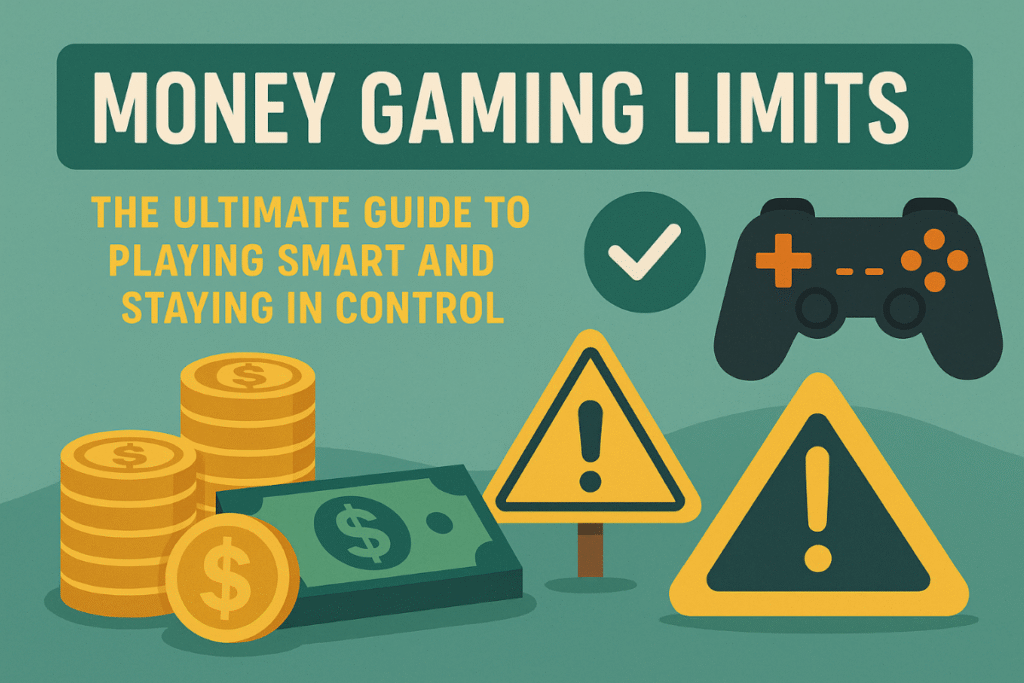overview
Gaming has evolved far beyond a casual pastime—it’s now a multi-billion-dollar industry that blends entertainment with real financial stakes. From in-game purchases to gambling-style mobile games and online casinos, the line between gaming and money is getting thinner. That’s where Money Gaming Limits come in.
In this guide, we’ll break down what money gaming limits are, why they matter, and how to implement them effectively to protect your finances and your mental health. Whether you’re a casual gamer or a seasoned high-roller, this guide is your playbook to smarter and safer gaming.
What Are Money Gaming Limits?
Money gaming limits refer to pre-set boundaries you place on how much money you spend while gaming. These can include limits on:
- Daily/weekly/monthly spending
- In-game purchases (microtransactions)
- Deposits on online gambling platforms
- Loss limits to prevent chasing losses
- Session duration limits tied to money spent
These limits help prevent overspending, reduce the risk of addiction, and ensure that gaming remains a form of entertainment rather than a financial burden.
Why Money Gaming Limits Matter in 2025
1. The Rise of Real-Money Gaming
Online games and mobile apps are increasingly designed to monetize users through:
- Microtransactions
- Loot boxes
- NFTs and blockchain gaming
- Online casinos and betting apps
Without clear spending boundaries, it’s easy to spiral into a cycle of compulsive behavior and financial stress.
2. Psychology of Gaming: The Dopamine Trap
Games are designed to release dopamine, a chemical that makes us feel good. When tied to monetary rewards or purchases, it can lead to reward-driven spending, which is often irrational.
3. Increased Regulation and Responsible Gaming
Many jurisdictions are tightening regulations to protect players. Platforms are now required to offer tools for setting spending limits, cooling-off periods, and self-exclusion options.
Types of Money Gaming Limits You Should Know
1. Deposit Limits
These limit how much money you can add to your account over a certain period (e.g., $200 per week). They’re available on most online gaming and gambling platforms.
2. Wagering or Betting Limits
Set a cap on how much you can bet per game or per day. This helps prevent rapid losses and keeps things fun and controlled.
3. Loss Limits
A limit on how much you can lose in a session. If the limit is reached, the system will automatically stop you from playing or alert you.
4. Time-Based Limits Tied to Money
Some players find it helpful to limit gameplay time, especially when certain spending thresholds are hit.
5. Reality Checks
These are alerts or reminders that pop up after a set period or expenditure. They prompt the user to reflect on their activity.
How to Set Effective Money Gaming Limits
Step 1: Know Your Budget
Start by tracking your monthly income and expenses. Determine how much you can comfortably afford to spend on entertainment—and treat gaming as part of that budget.
Pro Tip: Use budgeting apps like Mint or YNAB to monitor your finances and sync gaming spend.
Step 2: Choose Your Gaming Type
Are you into mobile games with in-app purchases, or do you play poker or online slots? Different types of games require different strategies.
Step 3: Use Built-in Tools
Most platforms today offer built-in limit-setting tools. For example:
- Steam has parental controls
- PlayStation has spending limit options
- Betting platforms like FanDuel or Bet365 offer daily/monthly caps
Step 4: Set Limits and Test Them
Start small. For example, if you usually spend $100 a week, try cutting it to $75 and assess your experience.
Step 5: Review Monthly
Gaming habits evolve. Review your limits monthly and adjust if needed based on your experience and goals.
Money Gaming Limits and Mental Health
Spending too much on games can lead to stress, guilt, and even depression. Implementing money gaming limits helps maintain a healthy relationship with gaming by:
- Preventing financial distress
- Encouraging breaks and balance
- Avoiding addictive loops
- Supporting better decision-making
A healthy mind = smarter gaming.
Parental Controls and Teen Gamers
Parents should be especially vigilant about money gaming limits for minors. Teens are exposed to:
- Skin purchases in Fortnite
- Loot boxes in FIFA
- Virtual coins in Roblox
Most consoles and mobile devices offer parental control tools to:
- Set spending caps
- Block purchases
- Restrict gameplay hours
The Role of Game Developers in Promoting Limits
Game developers have a responsibility to design ethical monetization systems. Some companies have begun implementing:
- Spending dashboards
- Limit nudges
- Optional spending caps
Responsible design not only helps players but also builds long-term brand trust.
Legal and Regulatory Perspective
As of 2025, regulations in several countries mandate platforms to:
- Disclose odds in loot boxes
- Offer opt-out mechanisms for real-money features
- Provide clear options to set limits
Platforms that fail to comply risk heavy fines or bans. This shows how crucial it is to align user experience with financial responsibility.
Real-Life Case Study: How Setting Limits Saved a Gamer $3,000
David, a 28-year-old software developer, found himself spending over $500/month on in-game purchases. After hitting a financial low, he implemented money gaming limits using his platform’s tools.
Over six months, he:
- Reduced monthly spend to $100
- Tracked his moods and found higher satisfaction
- Saved over $3,000 in total
His verdict: “Gaming became fun again. It no longer felt like a trap.”
Best Tools and Apps for Enforcing Money Gaming Limits
Here are some top-rated tools to help you stay in control:
| Tool | Type | Features |
|---|---|---|
| BetBlocker | Free Software | Blocks gambling sites |
| GamBan | Subscription | Filters gambling-related content |
| Freedom App | Productivity | Blocks access during set times |
| Spending Tracker | Budget App | Monitors in-app/game purchases |
| PlayStation Family Tools | Console | Limits time and spending for kids |
FAQs About Money Gaming Limits
1. Are money gaming limits legally required?
Not everywhere, but in many countries and states, gambling platforms must offer limit-setting tools. Casual gaming platforms often offer voluntary tools.
2. Can I change my money gaming limits later?
Yes. Most platforms allow you to change them, although some require a waiting period (like 24 hours) before new limits take effect.
3. Are money gaming limits effective against addiction?
They are a useful tool, but not a cure. They work best when combined with self-awareness, counseling, or support from professionals if needed.
4. How do I talk to my child about spending in games?
Start by explaining the concept of real money vs virtual rewards. Use parental controls to guide behavior, and involve them in setting limits.
5. Can I get refunded for accidental in-game purchases?
Some platforms offer limited refunds for unauthorized or accidental purchases, especially for minors. Always check the platform’s refund policy.
Conclusion: Play Smart, Stay in Control
Money gaming limits are not about restricting fun—they’re about empowering you to enjoy games without regrets. By setting clear, realistic boundaries and using the right tools, you take control of your gaming experience and finances.
In a world where games are designed to encourage spending, being informed and prepared is your ultimate cheat code. Make gaming fun again—without breaking the bank.



